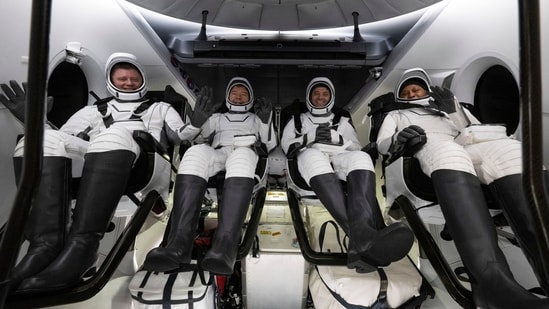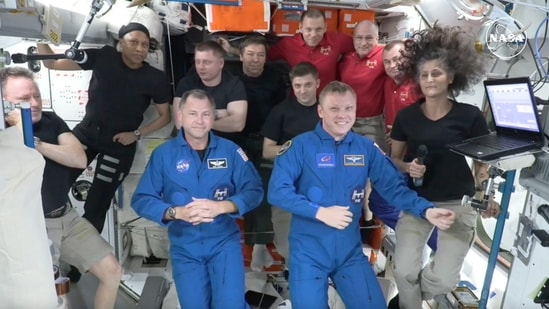The Crew-8 members (three NASA astronauts and one Russian cosmonaut) landed in the Gulf of Mexico off Pensacola, Florida, on Friday, October 25. Their homecoming journey to Earth successfully concluded after an extended nearly eight-month stay at the International Space Station following their early March liftoff in a SpaceX Crew Dragon capsule.
NASA’s SpaceX Crew-8 astronauts Matthew Dominick, Michael Barratt, and Jeanette Epps, and Roscosmos cosmonaut Alexander Grebenkin, depart their crew quarters for the launch pad before their mission to the International Space Station, aboard a SpaceX Falcon 9 rocket from the Kennedy Space Center in Cape Canaveral, Florida, U.S., March 3, 2024.(REUTERS)
According to CNN, the quartet, composed of Roscosmos cosmonaut Alexander Grebenkin and NASA astronauts Michael Barratt, Matthew Dominick, and Jeanette Epps, was immediately transferred to a Florida medical facility near their splashdown site. The unexpected development ultimately caused one unspecified astronaut to be left behind in the hospital due to a “medical issue.” The other three flew back to NASA’s Johnson Space Center in Houston after a health evaluation.
 This photo provided by NASA shows Roscosmos cosmonaut Alexander Grebenkin, left, NASA astronauts Michael Barratt, second from left, Matthew Dominick, second from right, and Jeanette Epps, right, inside the SpaceX Dragon Endeavour spacecraft onboard the SpaceX recovery ship MEGAN shortly after having landed in the Gulf of Mexico off the coast of Pensacola, Florida, Friday, Oct. 25, 2024.(AP)
This photo provided by NASA shows Roscosmos cosmonaut Alexander Grebenkin, left, NASA astronauts Michael Barratt, second from left, Matthew Dominick, second from right, and Jeanette Epps, right, inside the SpaceX Dragon Endeavour spacecraft onboard the SpaceX recovery ship MEGAN shortly after having landed in the Gulf of Mexico off the coast of Pensacola, Florida, Friday, Oct. 25, 2024.(AP)
NASA has not disclosed hospitalised Crew-8 astronaut’s details
“To protect the crew member’s medical privacy, specific details on the individual’s condition or identity will not be shared,” NASA news chief Cheryl Warner shared in a Friday afternoon statement. No further details about the fourth member still at Ascension Sacred Heart Pensacola were released at the time of writing.
The statement, however, explained that the astronaut admitted to the hospital was in “stable condition under observation as a precautionary measure.”
Medical checkouts after extended space stays are routine
While this was SpaceX’s longest human mission to space, subsequent medical checkouts are nothing out of the ordinary after such extended routine missions. Astronauts often need time to readjust to Earth’s gravity after experiencing zero gravity in space for months.
Also read | Harris heckled at Houston rally; gate-crashing Trump supporters escorted out as chaos breaks out
 In this image made from a NASA livestream, the two astronauts stuck at the International Space Station since June 2024, Butch Wilmore, far left, and Suni Williams, far right, welcome two new residents who flew up on SpaceX, NASA’s Nick Hague, front left in blue, and the Russian Space Agency’s Alexander Gorbunov, front right in blue, Sunday, Sept. 29, 2024. Behind them, from left in black, are NASA’s Jeanette Epps, Russia’s Alexander Grebenkin, NASA’s Mike Barratt and NASA’s Matthew Dominick. From left, wearing red, are Russia’s Ivan Vagner, NASA’s Don Pettit and Russia’s Alexei Ovchinin. (AP)
In this image made from a NASA livestream, the two astronauts stuck at the International Space Station since June 2024, Butch Wilmore, far left, and Suni Williams, far right, welcome two new residents who flew up on SpaceX, NASA’s Nick Hague, front left in blue, and the Russian Space Agency’s Alexander Gorbunov, front right in blue, Sunday, Sept. 29, 2024. Behind them, from left in black, are NASA’s Jeanette Epps, Russia’s Alexander Grebenkin, NASA’s Mike Barratt and NASA’s Matthew Dominick. From left, wearing red, are Russia’s Ivan Vagner, NASA’s Don Pettit and Russia’s Alexei Ovchinin. (AP)
Having launched on March 4, the Crew-8 team faced repeated delays due to numerous reasons (including additional weather delays), facing a similar fate as (and also attributed to) the Boeing Starliner’s astronauts Sunita Williams and Butch Wilmore. As per the latest development, the Crew-8 team members were stationed in space for three months longer than the Starliner duo. However, that timeline is expected to be crossed with Williams and Wilmore’s return aboard the Crew-9 SpaceX capsule scheduled not before February 2025.
“(Crew-8 was) the longest duration in space for a US crewed vehicle at 235 days,” said Richard Jones, NASA’s deputy manager of the Commercial Crew Program, during a 5 am ET briefing. “Right now the crew is doing great. They are going to spend a little bit of time on the recovery vessel going through their medical checks,” he said at the time. “They’ll soon be on their way back to Houston after all of those are done.”
 In this NASA handout, Support teams work around the SpaceX Dragon Endeavour spacecraft shortly after it landed with NASA astronauts Matthew Dominick, Michael Barratt, and Jeanette Epps, and Roscosmos cosmonaut Alexander Grebenkin aboard in the Gulf of Mexico off the coast of Pensacola, Florida on October 25, 2024.(Getty Images via AFP)
In this NASA handout, Support teams work around the SpaceX Dragon Endeavour spacecraft shortly after it landed with NASA astronauts Matthew Dominick, Michael Barratt, and Jeanette Epps, and Roscosmos cosmonaut Alexander Grebenkin aboard in the Gulf of Mexico off the coast of Pensacola, Florida on October 25, 2024.(Getty Images via AFP)